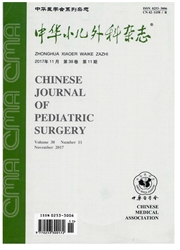

 中文摘要:
中文摘要:
目的通过观察Hoxd-13在正常和肛门直肠畸形大鼠胚胎肛门直肠发育过程中的表达情况,探讨Hoxd-13基因在肛门直肠畸形发生机制中的作用。方法研究对象分为肛门直肠畸形组(n=75)和对照组(n=108),应用乙烯硫脲致畸Wistar大鼠(n=20)建立肛门直肠畸形动物模型,分别在E13、E14、E15、E16、E18和E21(Ex表示大鼠妊娠第X天)剖宫取胎,正中矢状面连续石蜡切片,进行Hoxd-13免疫组化染色,连续动态观察Hoxd-13在正常和肛门直肠畸形大鼠胚胎肛门直肠发育过程中的表达,并联合应用RTPCR方法研究Hoxd-13mRNA在各时期的表达情况。结果①免疫组化染色结果:正常大鼠胚胎中,Hoxd-13表达于尿直肠隔的间质以及后肠、泄殖腔膜和尿生殖窦的上皮层。肛门直肠畸形组大鼠胚胎中,在E13~16,Hoxd-13在尿直肠隔间质、后肠上皮层、泄殖腔膜或瘘管上皮层的表达减弱,平均光密度值明显减小,与对照组相比,差异有统计学意义(P〈0.05)。在2组大鼠胚胎中,Hoxd-13的表达随着胎龄的增长呈总体增加的趋势。②RT-PCR结果:Hoxd-13mRNA扩增条带在肛门直肠畸形组呈弱带或无带,在对照组均呈亮带。其相对表达量随着胎龄的增长呈总体增加的趋势。在E13~16,肛门直肠畸形组Hoxd-13mRNA的表达水平低于对照组,差异有统计学意义(P〈0.05)。RT-PCR结果与免疫组化结果一致。结论Hoxd-13在肛门直肠畸形大鼠胚胎尿直肠隔间质以及后肠上皮层、泄殖腔膜或瘘管上皮层表达减弱,Hoxd-13基因表达异常可能与肛门直肠畸形的发生有关。
 英文摘要:
英文摘要:
Objective To investigate the expression of Hoxd-13 in the development of anorectal malformations(ARMs) in Ethylenethiourea(ETU)-treated rat embryos, and try to explore its role in the morphogenesis of ARMs. Methods Rat embryos were divided into the ARMs group (n = 75) and control group (n = 108). The ETU murine model of ARMs was employed. The embryos were taken out and made into median sagittal plane sections on E13, El4, El5, E16, E18 and E21. Temporalspatial study was carried out to detect Hoxd-13 expression by immunohistochemical assay and RT- PCR. Results In immunohistochemical staining, Hoxd-13 expression was confined to the mesenchyme of the urorectal septum (URS) and the epithelia of the hindgut, cloaca membrane and urogenital sinus in the control group. The mean optical density of Hoxd-13 in the mesenchyme of URS and the epithelium of the hindgut, cloaca membrane or fistula membrane was significantly lower in the ARMs group than that in the control group on E13-16 (P〈0. 05). RT-PCR amplification showed that Hoxd-13 gene was weak positive or negative in ARMs group, while positive in the control group. The amount of Hoxd-13 mRNA in the embryos with ARMs was significantly lower than that in the control group on E13-16 (P〈0. 05). The RT-PCR results were consistent with the immnohistochemical staining results. Conclusions The decreased expression of Hoxd-13 gene in the mesenchyme of URS and the epithelium of the hindgut, cloaca and urogenital sinus may be related to the development of ARMs.
 同期刊论文项目
同期刊论文项目
 同项目期刊论文
同项目期刊论文
 期刊信息
期刊信息
